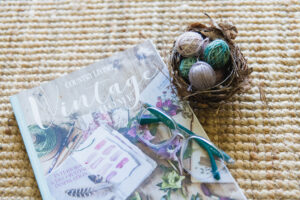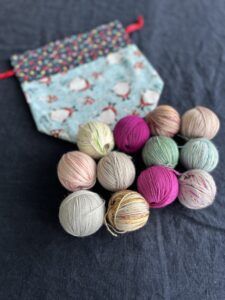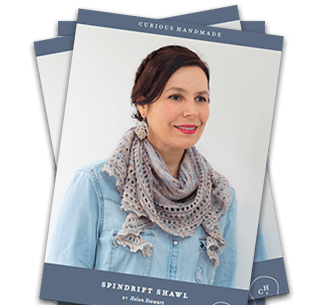A guide to double-stranded knitting for Knitvent 2025
This year’s Knitvent is a scrappy season, celebrating the beautiful little leftovers we’ve saved from past projects.
Some of the patterns this season are written for DK weight yarn. I love using DK for accessories: it’s extra cosy and knits up that bit faster…ideal for gift-knitting.
If your stash is full of fingering or sock-weight yarn scraps you want to use up…perfect! You already have everything you need. This quick guide walks you through how to hold two yarns together to create your own DK-weight blend. It’s an easy, creative way to use up scraps, mix minis, and discover beautiful new colour combinations — perfect for a scrappy season of cosy, joyful knitting.
Why hold yarn double?
- To use what you have. Fingering weight is the most common stash yarn for many knitters, so doubling up lets you knit DK-weight patterns without a trip to the yarn shop.
- To play with colour. Pair two shades to create gentle marls, bold contrasts, or subtle tonal shifts.
- To experiment with texture. Mix fibres — perhaps a strand of soft merino with a touch of halo from silk-mohair or suri alpaca — for extra depth and coziness.
- To knit faster. Two strands mean thicker fabric and larger needles, so your project grows quickly.
How to estimate yarn weight
Two strands of fingering weight held together will usually approximate DK weight, but results vary depending on the yarn.
Here’s a rough guide:
| Combined strands | Approx. equivalent |
| 2 laceweights | Fingering / 4 ply / sock |
| 2 fingering / 4 ply / sock | DK |
| Fingering + laceweight | Heavy fingering/Sport |
| 2 sport weights | Worsted |
Yarn thickness and fibre content can shift things a little, so if you want an exact match for a pattern, it’s always worth making a small swatch first to check gauge.
Colour play
- Monochrome: Two strands of the same shade give you a classic, even look—great for showing off texture stitches.
- Tonal blend: Combine two close colours (for example, two blues) for gentle movement and depth.
- High contrast: Mix opposites or brights for cheerful, painterly marls—perfect for scrappy knitting!
- Neutrals + accents: Add a strand of cream or grey to calm a busy palette, or slip in pops of leftover minis for stripes and surprises.
When holding yarns together, wind them into one cake or pull from two separate balls, whatever feels easiest to manage.
Estimating amounts
Because you’re using two strands at once, you’ll need roughly double the amount compared to a single strand.
For example, if a pattern calls for 100 g of DK yarn, you’ll need about 200 g of fingering weight yarn held double.
This is the perfect opportunity to use up partial skeins and advent minis: gather similar tones, or go completely scrappy for a unique marled effect.
The spirit of the season
Double-stranding is wonderfully forgiving. The colours blend, the stitches soften, and the end result feels comforting and completely unique to you: which is exactly what Knitvent is all about.
So if you’ve been wondering what to do with all those small leftovers, take this as your invitation to experiment. Play with pairings, trust your eye, and enjoy watching your yarn transform into something new and beautiful.




